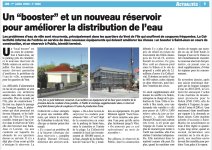JEK
Senior Insider

A “booster” and a new tank
to improve water distribution
City water problems are recurrent, mainly in the Le Vent districts of the island which suffer from frequent cuts. The Community informs of the entry into service of two new pieces of equipment which should improve things: a booster in Saint-Jean under construction, and a tank in Public, soon to be completed.
A “local booster” is being built in Saint-Jean, in the parking lot near the cemetery, and the new Public tank will come into service in mid-July. These two investments should make it possible to improve the problem of city water, especially for the Vent districts.
The water supply difficulties in these neighborhoods have increased in recent years, but they are not new. More people on the island, more buildings? In any case, since the passage of Hurricane Irma, the phenomenon which was punctual has become frequent, and the inhabitants of the Wind of the island are exasperated. Before the water arrives in the Vitet reservoir, it must pass through all of Saint John and Lorient, via a pipe on which the subscribers of these dense districts use it. There is no more water before it reaches the reservoir. The
Once this small building is constructed, it will house equipment from the Saur to put pressure back on the drinking water line. To the public the additional storage in this new tank should give more flexibility to the water production plant.
started more than a year ago has been delayed due to the movement of the Yellow Vests and then the Covid-19, will soon enter service. This large block wedged in the shoehorn between Sidem and the waste disposal site cost the Community nearly 2.1 million euros. It will house a water supply of 800 cubic meters divided into two tanks, to facilitate the maintenance of the tanks.
This additional stock should give a boost to Sidem, the company in charge of producing water. This works just in time, with very variable demand (“it can go from 3,500 to 2,900 cubic meters from day to tomorrow”, says Sophie Durand-Olivaud) but above all very strong. So much so that the factory team can no longer find a time to shut down a machine in order to carry out the essential maintenance. So she maintains the equipment as best she can. In addition, when the machines are
forced to stop, for example in the event of heavy swells, the lack of water on the network is immediately felt. The new tank must make it possible, by playing with this additional stock, to avoid ruptures for consumers.
Last November, after a tourist season marked by long water cuts in 2018-2019, the Community announced the purchase of a temporary desalination machine for Sidem (JSB 1349), in order to responding to the emergency, the capacity of the plant (4,200 m3 / day maximum) being insufficient compared to demand in high season. This second-hand machine purchased in Saint Martin is currently being adjusted and adjusted. In the longer term, when a second incinerator is built on the property site, a new machine should be installed to produce water using steam.
Collectivité therefore undertook to lay a different pipe, which will connect the Colombier reservoir to that of Vitet, so that the latter can be filled.
“There is also a problem due to the identical height of the two tanks,” adds Sophie Durand Olivaud, director of technical services.
picnics. “So we need to overpress the pipe to supply Vitet. This is the object of the construction in progress on the Saint-Jean car park, between the cemetery and the entrance to the beach. The Collective builds the premises (an investment of 100,000 euros), and the Saur, responsible for the distribution of water on the island, installs there-
will read its equipment. This small building called “local booster” will have to pressurize the water so that it can more easily reach Vitet. "We would like it to be operational in November".
In addition, the Public reservoir, whose construction
9




